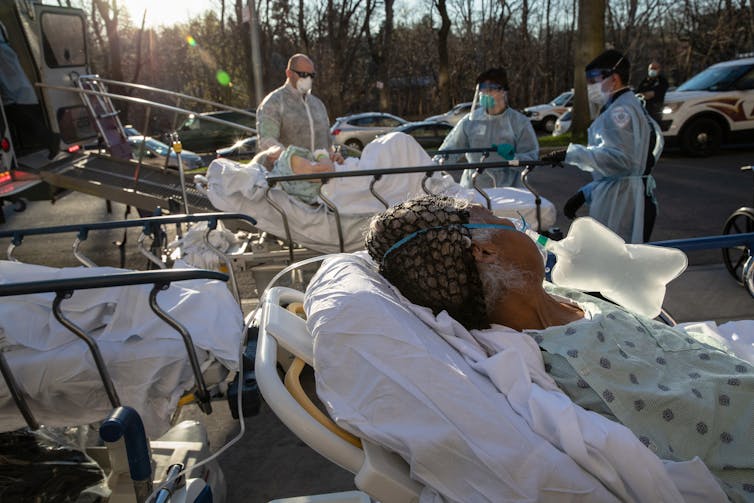While the US is reeling from COVID-19, the Trump administration is trying to take away health care
In the middle of the pandemic, the Trump administration is pursuing policy and a court ruling that would take away health care from millions. Two scholars explain the details.

The death toll from COVID-19 keeps rising, creating grief, fear, loss and confusion.
Unfortunately for us all, the pain only begins there. Other important health policy news that would ordinarily make headlines is buried under the crushing weight of the coronavirus. Many have not had time to notice or understand the Trump administration’s efforts to wreck health care coverage.
We are both professors at Boston University School of Public Health who study health insurance, one using economics and statistics and the other focusing on law and policy. We have researched the big picture of COVID-19’s impact on the safety net and the details of how our federalist system, with states having considerable control over policy, has made a coordinated response to the pandemic more difficult.
Here, we highlight two major actions by the Trump administration that should be receiving more attention – attempting to cap federal Medicaid funding, and arguing to the Supreme Court that the entire Affordable Care Act should be struck down.

Limits on Medicaid funding
Complicated language and political posturing make it hard to understand health care in the best of times. This is particularly true for proposals to change the funding for Medicaid, the health insurance program for low-income Americans that also covers many disabled and elderly people.
Medicaid has historically been funded like this: States pay a percentage of Medicaid costs, and the federal government covers the rest. The federal match ranges from 50% to as much as 83% of every dollar. It doesn’t matter whether a state has one thousand or one million Medicaid enrollees, that same cost sharing applies. Uncapped federal funding gives Medicaid flexibility to meet that need.
The Trump administration wants to change the promise of unlimited federal funding and instead use a payment method often called “block grants.”
Block grants are pre-set amounts of money that the federal government offers to states, which then have control over the money within broad guidelines. While that may sound harmless and even appealing to some, block granting reduces the amount of federal money available and shifts the risk of economic, health, and other emergencies to states. Medicaid block grants would set limits on how much money the federal government spends, either in total or per person.

Medicaid has never been capped this way in its 55-year history, but block granting for Medicaid has long been an unfulfilled dream for conservatives, with Ronald Reagan, Newt Gingrich, and Paul Ryan trying but failing to make block grants a reality.
A work-around
When the GOP-dominated Congress tried in 2017 to repeal the ACA, many replacement bills featured Medicaid block grants. The bills failed in the Senate, with the late Sen. John McCain, R-Arizona, casting a famous deciding vote.
The Trump administration decided to try a different road. In January 2020, the Centers for Medicare and Medicaid Services issued a letter to state Medicaid directors describing a new Healthy Adult Opportunity policy that would fundamentally change the way Medicaid has always worked by implementing block grants.
Instead of the current partnership, in which the pie (Medicaid spending) can expand but the pieces (federal and state share of costs) stay the same size relatively, this new block grant policy would provide states either a set dollar amount for each enrollee (a per capita cap) or for their entire program (a fixed annual grant). Either way, the state would be responsible for any extra costs. To be clear, we and others believe this policy is illegal without a change in federal law.
So why would states pursue this? Political ideology and less federal oversight are big factors.
Giving states greater control over health policy could encourage states to find savings in their Medicaid programs. But unexpected spending on Medicaid, such as spikes in enrollment from natural disasters, could lead states to cut benefits, payments to providers, or other necessary services. This could make good quality care harder to get. It could also lead states to shift funding away from other essential services, like education, to meet medical needs.
We believe this is an especially bad time to pick this fight, while the nation tries to prevent spikes in COVID-19 and state budgets are in decline. Limiting the amount of money states have for Medicaid could not only limit health care access for the 65 million Americans already enrolled in Medicaid, but also potentially millions more who may need it as a result of the pandemic.
Killing the ACA
The ACA has faced near constant legal and political challenges since it became law a decade ago. Even enthusiastic supporters admit that it is far from perfect. But, some 20 million people gained insurance through the law.
The first challenge came when some states claimed that the law’s individual mandate, a requirement to have health insurance or pay a penalty, was unconstitutional. The Supreme Court ruled in 2012 that the mandate is constitutional, and the law was implemented.
In 2017, the Republicans controlling Congress tried but failed to repeal the ACA. Congress was only able to reduce the tax penalty to zero for the individual mandate, meaning the law still requires having health insurance coverage but the penalty is now $0.
Now, states argue once again that the mandate is unconstitutional because the penalty fails to “produce at least some revenue.” This new case is scheduled to be heard by the Supreme Court on Nov. 10. Texas v. California is the third major legal challenge to the ACA, but the first time that the federal government will not defend the law in court.
Texas leads 17 other states, with full support from the Trump administration, in arguing that the ACA cannot exist without the individual mandate penalty because the law is not “severable” – meaning that if one part of a law fails, then the entire law falls.
Of course, Congress did exactly that, severing the penalty from the rest of the ACA when it enacted the Tax Cuts and Jobs Act of 2017.
And, the Supreme Court already decided that the ACA is severable when it made Medicaid expansion optional in 2012. This case has been called “balderdash” by legal scholars, yet the court could issue a decision in a few months that eliminates the ACA.
If the ACA is struck down, that means the loss of coverage for preexisting conditions, the return of annual or lifetime caps, or policies being revoked for cancer patients. Those who don’t earn much money still deserve good health care. Nearly everyone will feel it if the Trump administration and Texas are successful, regardless of whether your health insurance is through your work, HealthCare.gov, Medicaid or Medicare.
Staying healthy is first priority during this pandemic, but understanding that health insurance could be on the brink of evaporating for millions is a close second.
Paul Shafer has received funding in the past three years from the Kate B. Reynolds Charitable Trust, Robert Wood Johnson Foundation, Horowitz Foundation for Social Policy, and the North Carolina Translational and Clinical Sciences Institute.
Nicole Huberfeld does not work for, consult, own shares in or receive funding from any company or organization that would benefit from this article, and has disclosed no relevant affiliations beyond their academic appointment.
Read These Next
The Supreme Court’s decision on birthright citizenship will depend on its interpretation of one phra
Advocates for each side will provide a different explanation for who falls under ‘the jurisdiction’…
Vaccine committee votes to scrap universal hepatitis B shots for newborns despite outcry from childr
The decision undoes a highly effective 34-year prevention strategy that has nearly eliminated early…
Buying a gift for a loved one with cancer? Here’s why you should skip the fuzzy socks and give them
Gifts that make a true connection acknowledge the ugly parts of illness and provide relief from daily…






